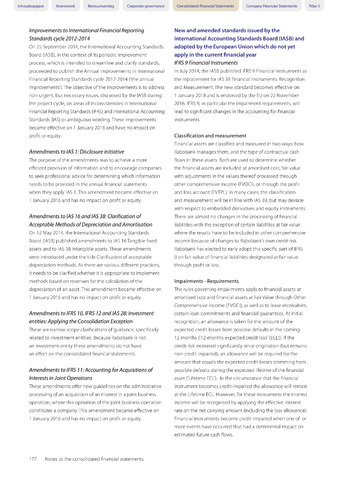Inhoudsopgave Voorwoord Bestuursverslag Corporate governance
Consolidated Financial Statements Company Financial Statements Pillar 3
Improvements to International Financial Reporting
Standards cycle 2012-2014
On 25 September 2014, the International Accounting Standards
Board (IASB), in the context of its periodic improvement
process, which is intended to streamline and clarify standards,
proceeded to publish the Annual improvements in International
Financial Reporting Standards cycle 2012-2014 ('the annual
improvements').The objective ofthe improvements is to address
non-urgent, but necessary issues, discussed by the IASB during
the project cycle, on areas of inconsistencies in International
Financial Reporting Standards (IFRS) and International Accounting
Standards (IAS) or ambiguous wording. These improvements
became effective on 1 January 2016 and have no impact on
profit or equity.
Amendments to IAS I: Disclosure initiative
The purpose ofthe amendments was to achieve a more
efficient provision of information and to encourage companies
to seek professional advice for determining which information
needs to be provided in the annual financial statements
when they apply IAS 1This amendment became effective on
1 January 2016 and has no impact on profit or equity.
Amendments to IAS 76 and IAS 38: Clarification of
Acceptable Methods of Depreciation and Amortisation
On 12 May 2014, the International Accounting Standards
Board (IASB) published amendments to IAS 16Tangible fixed
assets and to IAS 38 Intangible assets.These amendments
were introduced under the title Clarification of acceptable
depreciation methods. As there are various different practices,
it needs to be clarified whether it is appropriate to implement
methods based on revenues for the calculation ofthe
depreciation of an asset. This amendment became effective on
1 January 2016 and has no impact on profit or equity.
Amendments to IFRS i0, IFRS 12 and IAS 28: Investment
entities: Applying the Consolidation Exception
These are narrow-scope clarifications of guidance, specifically
related to investment entities. Because Rabobank is not
an investment entity these amendments do not have
an effect on the consolidated financial statements.
Amendments to IFRS 11: Accounting for Acquisitions of
Interests in Joint Operations
These amendments offer new guidelines on the administrative
processing of an acquisition of an interest in a joint business
operation, where this operation of the joint business operation
constitutes a company.This amendment became effective on
1 January 2016 and has no impact on profit or equity.
New and amended standards issued by the
International Accounting Standards Board (IASB) and
adopted by the European Union which do not yet
apply in the current financial year
IFRS 9 Financial Instruments
In July 2014, the IASB published IFRS 9 Financial Instruments as
the replacement for IAS 39 Financial Instruments: Recognition
and Measurement.The new standard becomes effective on
1 January 2018 and is endorsed by the EU on 22 November
2016. IFRS 9, in particular the impairment requirements, will
lead to significant changes in the accounting for financial
instruments.
Classification and measurement
Financial assets are classified and measured in two ways: how
Rabobank manages them, and the type of contractual cash
flows in these assets. Both are used to determine whether
the financial assets are included at amortised cost, fair value
with adjustments in the values thereof processed through
other comprehensive income (FVOCI), or through the profit
and loss account (FVTPL). In many cases, the classification
and measurement will be in line with IAS 39, but may deviate
with respect to embedded derivatives and equity instruments.
There are almost no changes in the processing of financial
liabilities with the exception of certain liabilities at fair value
where the results have to be included in other comprehensive
income because of changes to Rabobank's own credit risk.
Rabobank has elected to early adopt this specific part of IFRS
9 on fair value of financial liabilities designated at fair value
through profit or loss.
Impairments - Requirements
The rules governing impairments apply to financial assets at
amortised cost and financial assets at Fair Value through Other
Comprehensive Income (FVOCI), as well as to lease receivables,
certain loan commitments and financial guarantees. At initial
recognition, an allowance is taken for the amount ofthe
expected credit losses from possible defaults in the coming
12 months ('12-months expected credit loss'(ECL)). If the
credit risk increased significantly since origination (but remains
non-credit impaired), an allowance will be required for the
amount that equals the expected credit losses stemming from
possible defaults during the expected lifetime of the financial
asset ('Lifetime ECL'). In the circumstance that the financial
instrument becomes credit-impaired the allowance will remain
at the Lifetime ECL. Flowever, for these instruments the interest
income will be recognised by applying the effective interest
rate on the net carrying amount (including the loss allowance).
Financial instruments become credit-impaired when one of or
more events have occurred that had a detrimental impact on
estimated future cash flows.
177 Notes to the consolidated financial statements

